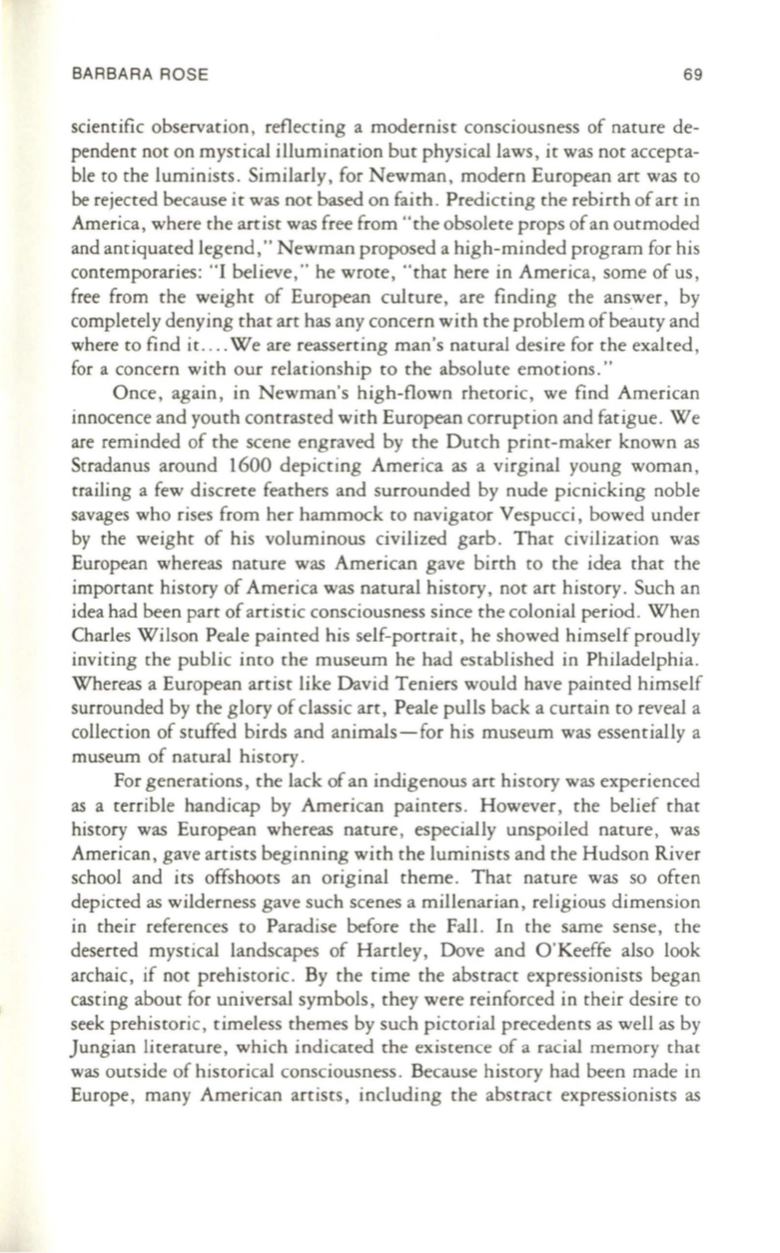
BARBARA ROSE
69
scientific observation, reflecting a modernist consciousness of nature de–
pendent not on mystical illumination but physical laws, it was not accepta–
ble to the luminists . Similarly , for Newman, modern European art was to
be
rejected because it was not based on faith. Predicting the rebirth ofart in
America, where the artist was free from "the obsolete props of an outmoded
and antiquated legend," Newman proposed a high-minded program for his
contemporaries: "I believe," he wrote, "that here in America, some of us,
free from the weight of European culture, are finding the answer, by
completely denying that art has any concern with the problem of beauty and
where to find it. ... We are reasserting man's natural desire for the exalted,
for a concern with our relationship to the absolute emotions ."
Once, again, in Newman's high-flown rhetoric , we find American
innocence and youth contrasted with European corruption and fatigue . We
are reminded of the scene engraved by the Dutch print-maker known as
Stradanus around 1600 depicting America as a virginal young woman,
trailing a few discrete feathers and surrounded by nude picnicking noble
savages who rises from her hammock to navigator Vespucci, bowed under
by the weight of his voluminous civilized garb. That civilization was
European whereas nature was American gave birth to the idea that the
important history of America was natural history, not art history. Such an
idea had been part of artistic consciousness since the colonial period . When
Charles Wilson Peale painted his self-portrait, he showed himself proudly
inviting the public into the museum he had established in Philadelphia .
Whereas a European artist like David Teniers would have painted himself
surrounded by the glory of classic art, Peale pulls back a curtain to reveal a
collection of stuffed birds and animals-for his museum was essentially a
museum of natural history.
For generations, the lack of an indigenous art history was experienced
as a terrible handicap by American painters . However, the belief that
history was European whereas nature, especially unspoiled nature, was
American, gave artists beginning with the luminists and the Hudson River
school and its offshoots an original theme. That nature was so often
depicted as wilderness gave such scenes a millenarian, religious dimension
in their references to Paradise before the Fall.
In
the same sense, the
deserted mystical landscapes of Hartley, Dove and O 'Keeffe also look
archaic, if not prehistoric. By the time the abstract expressionists began
casting about for universal symbols, they were reinforced in their desire to
seek prehistoric, timeless themes by such pictorial precedents as well as by
Jungian literature, which indicated the existence of a racial memory that
was outside of historical consciousness. Because history had been made in
Europe, many American artists, including the abstract expressionists as


